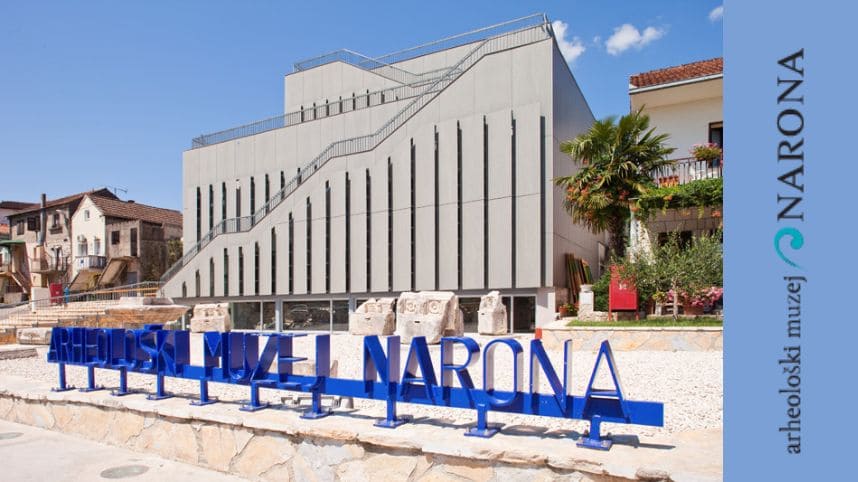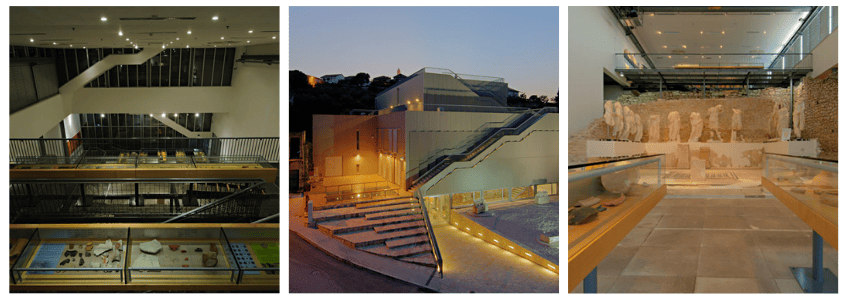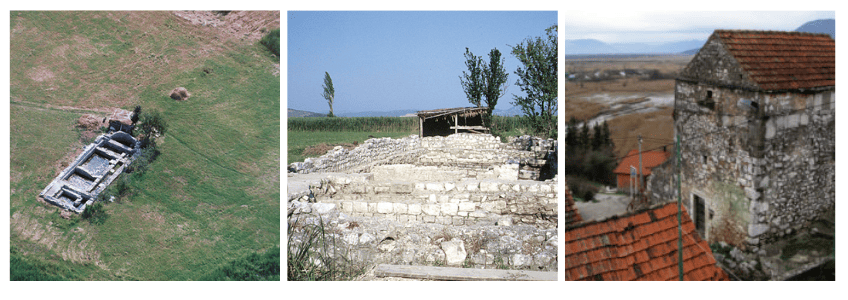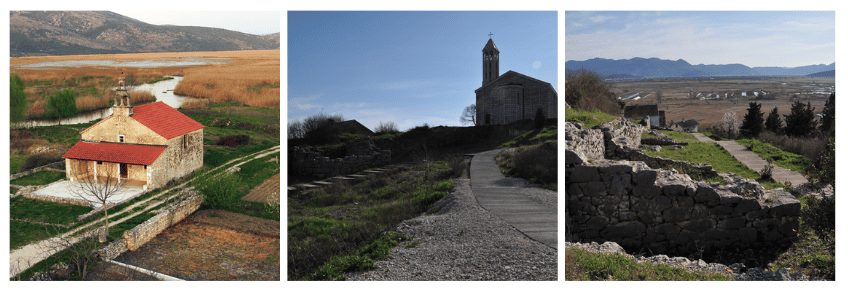Museum Info
During 1995 and 1996, archaeological excavations were carried out at the Plečaš Stables site, resulting in the sensational discovery of the remains of a Roman temple – the Augusteum – and 17 marble sculptures, both life-size and over life-size. This find inspired the idea of jointly presenting this unique archaeological site, showcasing not only the architectural remains but also numerous other archaeological materials.
The foundation stone for the future museum was laid on July 19, 2004, and the Archaeological Museum of Narona was established by a decree of the Government of the Republic of Croatia in 2005. Following exceptionally complex construction works, it was ceremonially opened on May 18, 2007, as the first museum in Croatia built in situ. This method of presenting an archaeological site has enriched Croatia’s museum offer and has only a few parallels on the European and global scale.
The museum has received three awards to date. Architect Goran Rako received the “Vladimir Nazor” Award for the museum’s design, the company MGA from Metković received the “Cemex” Award for construction, and the Archaeological Museum of Narona was awarded the Croatian National Tourist Board’s “Blue Flower” for its special contribution to enhancing Croatia’s tourism offer.
The Archaeological Museum of Narona actively participates in the Croatian Museum Association’s “Night of Museums” initiative, as well as in the activities of the Association’s Section for Museum Education and Cultural Action, and in the celebration of International Museum Day. During the summer months, the museum’s outdoor terraces host the cultural event “Narona Cultural Summer,” featuring theater performances, exhibitions, concerts, and book presentations.
Collection
The story of Narona’s treasures begins back in 1877, with the first recorded archaeological excavations. Later, in 1907, Austrian archaeologist Karl Patsch published the very first monograph on Narona, shedding light on the city’s Roman past. Decades of further research, especially in the 20th century, revealed countless discoveries – but the most spectacular one came in 1995–1996: the remains of a Roman temple, the Augusteum, along with seventeen marble statues of emperors and their families. This unique find completely transformed the village of Vid and inspired the creation of the museum you can visit today.
The Archaeological Museum of Narona showcases the most important pieces from these excavations in a stunning permanent exhibition. Visitors can explore both outdoor and indoor displays:
- Outdoors, on the plateau in front of the museum, you’ll see impressive fragments of Roman architecture and decorations from the ancient forum.
- Indoors, the highlight is the temple itself, preserved in situ, with statues of emperors displayed above a black-and-white mosaic floor – the most spectacular sight of the collection.
The exhibition also includes showcases filled with fascinating artifacts: coins, sculpture fragments, glass, ceramics, oil lamps, and everyday objects that tell the story of life in Narona. Thematic sections guide you through the city’s public life, architecture, religion, and burial customs.
The museum tour continues outside, where a small archaeological park and terraces display stone monuments and decorative fragments. Visitors end their journey by discovering a beautifully preserved Roman mosaic beneath a glass floor – almost like stepping back in time to a Roman taberna.
In total, around 900 artifacts are on display, taking you on a journey through Narona’s history from the 3rd century BC all the way to the 15th century.
Erešove Bare – Suburban Villa and Early Christian Church
In the marshy area known as Bare, just west of the Lower Town (extra muros), lies the archaeological site of Erešove Bare. Here, in the 2nd century AD, the Romans built a luxurious villa rustica. Remains of its architecture, fresco fragments, decorative stonework, and everyday ceramic and glass objects all testify to its past splendor. Excavations have revealed three construction phases: the first villa in the 2nd century, a rebuilt villa in the 3rd century, and a final phase dating to the late 4th and early 5th centuries.
In the 5th century, the villa was likely destroyed, and on its foundations an Early Christian church was erected. Built around the late 6th or early 7th century, the church featured a single nave, a narthex, and an apse – square on the outside, semicircular on the inside. Along the apse wall, archaeologists found a bench for the clergy, as well as fragments of an altar screen that separated the space for the congregation from that reserved for the clergy.
Today, the site of Erešove Bare has been conserved and presented to visitors, and can be explored as part of a tour of the Lower Town’s ancient city walls.
Ereš Tower – The First “Museum” of Ancient Narona
Next to the fourth Hellenistic tower on the southwestern part of the city walls rises the so-called Ereš Tower, built by the parish priest of Vid, Don Bariša Ereš, between 1825 and 1851. The tower consists of a two-story main house with two smaller annexes, constructed using numerous ancient remains.
Ereš Tower is often called the first open-air epigraphic museum of Ancient Narona, as many Latin inscriptions and other monuments were built into its walls. In total, forty Latin inscriptions and two in Croatian have been documented inside the house. Some of the Latin inscriptions are in fact 19th-century copies of Roman originals. Alongside them, the walls preserve a Roman cippus, an Early Christian impost, two limestone male torsos from antiquity, and the base of an Early Christian altar.
This unique 19th-century presentation of ancient monuments – the very first “epigraphic museum” of Narona – can still be visited today as part of a tour of the city walls.
St. Vid – Early Christian Church and Late Medieval Cemetery
On the site of today’s Church of St. Vid, an Early Christian basilica was built in the 5th century. It was a single-nave church, nearly 30 meters long and 25 meters wide, with a semicircular apse, a vestibule, and annexes on both the northern and southern sides. Unlike the typical churches of Salona, where annexes (if they existed) were placed only along one side wall, the Narona type of basilica featured smaller rooms along both side walls.
As Christianity spread from Narona into the Dalmatian hinterland, this architectural model also spread, especially along the Neretva River in present-day Herzegovina.
One of the northern annexes housed a baptistery, built at the same time as the church. Its location to the north of the basilica was common in Dalmatia, but its octagonal baptismal font, decorated with painted plaster imitating marble, is a rare feature for this region. With steps on both sides and a depth of 1.15 meters, the font was used for baptism by immersion. Interestingly, the lack of contemporary burials suggests that the church was not funerary in function, and it may even have served as Narona’s cathedral.
With the fall of Narona in the early 7th century, the basilica likely ceased to function. The site remained unused until the 14th and 15th centuries, when a late medieval cemetery was established directly over its ruins, erasing most of the church’s remains. In the 17th century, the present-day Church of St. Vid was built here, with part of its southern wall incorporating the remains of the ancient basilica.
Today, inside St. Vid’s Church, visitors can see an exhibition of finds from both the Early Christian church and the medieval cemetery, while panels illustrate the baptistery decorated with polychrome frescoes. Architectural remains of the basilica are still visible in and around the church. The stone rim of the baptistery has been raised to the floor level of the current church, while the original baptistery itself has been conserved in its authentic position.
City Walls – A Defensive System from Greek, Roman, and Early Christian Times
The earliest remains of Narona’s city walls date back to the 4th/3rd century BC, when the emporium was first established. At the top of the hill, archaeologists discovered two round towers flanking the main city gate, built in the style of Illyrian-Hellenistic fortifications. In the next phase, the city expanded fan-like down the southeastern slopes. The round towers were replaced by square and rectangular ones, while six towers and a gate on the northern side connected Narona with Bigeste (Ljubuški) and Salona.
Two preserved inscriptions tell us about the construction of these towers. One, from the Roman Republican period (mid–1st century BC), mentions magistrates and quaestors commissioning the building or repair of a tower. On the southwestern line of the walls, four rectangular towers were discovered, likely dating to the 2nd century BC, contemporary with the Hellenistic emporium unearthed beneath the Roman forum.
Next to the fourth ancient tower stands the Ereš Tower, a two-story house built by the parish priest of Vid, Don Bariša Ereš, in 1825. This unusual structure serves as a kind of open-air epigraphic museum, with numerous inscriptions from ancient Narona built into its walls.
In the third phase of development, at the end of the 1st century BC and the beginning of the 1st century AD, the city spread into the lower slopes, where the forum, the Augusteum temple, and other public buildings were built. This was the era of peace (Pax Romana) and Narona’s greatest prosperity, when fortifications were no longer necessary. However, in the second half of the 2nd century AD, during invasions by the Germanic Quadi and Marcomanni tribes, the city walls were once again rebuilt and repaired.
In late antiquity, during troubled times, Narona slowly declined. The city walls were reinforced once more, though with noticeably poorer construction techniques.
Step into the past and experience the wonders of Narona – where every artifact tells a story and every corner brings history to life!
You can find more about us and our work here.



